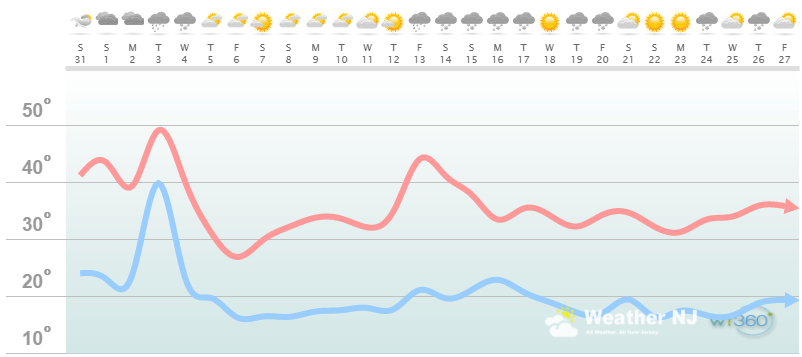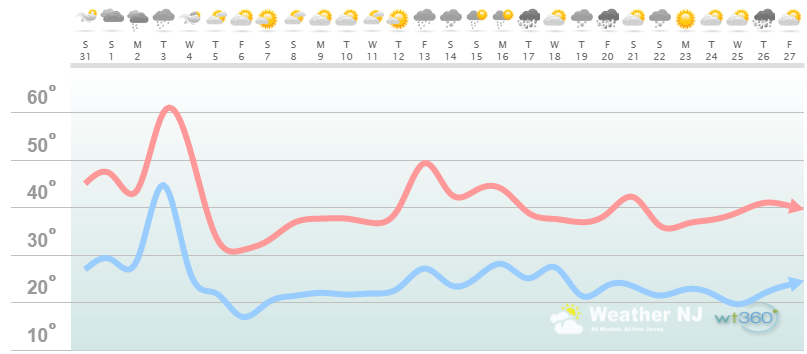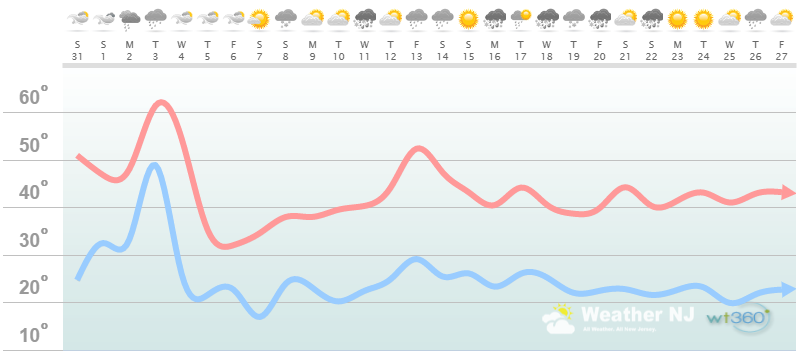What to Expect for January 2017

It’s time to harness the WeatherTrends360 proprietary weather algorithms to see how January of 2017 should play out. But first lets break New Jersey into proper climatological regions. We have the higher elevations of NNJ/NWNJ, the interior coastal plain (SWNJ through CNJ and into NENJ), and the coastal regions (most of SENJ). I’ll be representing each climatological region with a 28-day graph from weathertrends360 data followed by a brief discussion. Please keep in mind that these algorithms are documented with an 84% verification rate and are based on oceanic water cycles, time table series and very complex mathematics. The best takeaway from this are general trends (cool vs warm, rainy vs dry, etc). That’s what WeatherTrends360 does best with their proprietary mathematical analysis derived from over 150 years of reactive pattern data.
Higher Elevations of NNJ/NWNJ
(Sussex, Warren, Hunterdon, Morris, N. Somerset, and N. Passaic) – Known for little to no Atlantic Ocean influence, colder-snowier winters, and drier conditions in general when compared to the coast. This region is known to get hot when high pressure sits overhead during the summer and bitterly cold during Arctic outbreaks in the winter. Elevation is a major influence that separates this micro-climate from the rest of New Jersey. This region extends into NE PA (Poconos) and parts of NY State (Catskills).
Higher Elevation Discussion: There are two periods of temperature moderation jumping out. The first correlating to the Great Lakes cutter that will warm-sector the entire E US from Jan 2-4 with rain and S flow. The other period of moderation looks to happen mid-month. Both periods appear transient to the overall theme expected from about Jan 5-forward which are average/slightly below-average temperatures. While it’s not Arctic outbreak caliber cold, that should still be pretty cold this time of year. Precipitation appears to be modeled average for January 2017, if not slightly above-average. Both ingredients (cold and moisture) will be on the table this month for a snow storm. Timing will determine if the ingredients mix.
Interior Coastal Plain from SWNJ-CNJ-NENJ
(Salem, Gloucester, Camden, W. Burlington, Mercer, W. Monmouth, Middlesex, S. Somerset, Union, Essex, Hudson, Bergen, and S. Passaic) – Known for naturally higher temperatures due to lower elevations away from the oceanic influence. This region is also known as “heat island” due to transportation (I-95 corridor), smog, abundant asphalt, concrete, and other man-made substances that naturally absorb and retain heat moreso than natural protected land. This is why excessive heat warnings and air quality alerts are more common in this region. SWNJ always tends to run a few degrees warmer than NENJ but this region is very similar otherwise in micro-climate due to the parallel nature of the Appalachian Mountain elevations to the NW. The same micro-climate can be extended into SE PA and NE MD which tends to run just a little stormier than NJ. This however is what makes up the interior coastal plain.
Interior Coastal Plain Discussion: There are two periods of temperature moderation jumping out. The first correlating to the Great Lakes cutter that will warm-sector the entire E US from Jan 2-4 with rain and S flow. The other period of moderation looks to happen mid-month. Both periods appear transient to the overall theme expected from about Jan 5-forward which are average temperatures. While it’s not Arctic outbreak caliber cold, that should still be pretty cold this time of year. Precipitation appears to be modeled average for January 2017, if not slightly above-average. Both ingredients (cold and moisture) will be on the table this month for a snow storm. Timing will determine if the ingredients mix.
Coastal Regions of SENJ
(Cumberland, Cape May, Atlantic, E. Burlington, Ocean, and E. Monmouth) – Known for tremendous influence from the Atlantic Ocean. Oceanic influence keeps this zone cooler in the summer and warmer in the winter than the interior coastal plain and especially the higher elevations of NWNJ. In the summer, sea breeze fronts back into the coast and can ignite thunderstorms if enough instability is present. The cooler marine air slides under the hot air to the W and provides additional atmospheric lifting. This is both why it’s 5-15 degrees cooler at the shore than the Philly-Trenton area and why near-stationary thunderstorms can form along the coast capable of producing localized flash flooding. In the winter, the ocean is warmer than interior regions which plays a huge role in rain vs. snow—highly dependent on wind direction. When the winds chance from NE to N/NE, that’s usually when temps crash and change rain over to snow. Regardless, this micro-climate is well known, well documented and well expressed. This region extends into most of Delaware as well.
Coastal Region Discussion: There are two periods of temperature moderation jumping out. The first correlating to the Great Lakes cutter that will warm-sector the entire E US from Jan 2-4 with rain and S flow. The other period of moderation looks to happen mid-month. Both periods appear transient to the overall theme expected from about Jan 5-forward which are average/slightly below-average temperatures. While it’s not Arctic outbreak caliber cold, that should still be pretty cold this time of year. Precipitation appears to be modeled average for January 2017, if not slightly above-average. Both ingredients (cold and moisture) will be on the table this month for a snow storm. Timing will determine if the ingredients mix. Keep in mind that this region is subject to ocean Sea Surface Temperature (SST) influence. Right now SST off NJ are ranging from 41-45 and falling. They should bottom out in February in the upper-30s which is why late-January through February is peak snow season for the coastal plain. When we have that coastal low to our S/SE and onshore flow is happening, 37-degree air cools below freezing a lot quicker than the 45+ degree air we had for most of December. The difference at the surface means the snow/rain line setting up SE of the I-95 corridor vs NW of it.
Weathertrends360 is a complete, global, web solution to help retailers and suppliers capitalize on the weather and its influence on sales and marketing plans up to a year ahead. Learn how to become PROACTIVE vs REACTIVE with the weather in every phase of your business – how much inventory to buy/produce, where to allocate more/less, when to run weather-optimized advertising/marketing campaigns – weathertrends360 can help you determine all of this in minutes! 84% independently audited accuracy for both short-term and year-ahead forecasts for temperature and precipitation.
In English: We’re all mild through Jan 4. From Jan 5-forward we’re pretty average for January (which is relatively cold) aside from a mid-month transient warm-up. Plenty of precipitation is expected for January 2017. This might put a dent in the drought situation, that’s been building since July, but likely not enough to resolve it. If precipitation times with the cold (like we are watching the Jan 6-8 period for) then snow will happen. If timing remains poor then we will should continue alternating short temperature periods between colder/drier and milder/wetter periods.
A huge Happy New Year and great January 2017 to everyone! Be safe! JC
Jonathan Carr (JC) is the founder and sole operator of Weather NJ, New Jersey’s largest independent weather reporting agency. Since 2010, Jonathan has provided weather safety discussion and forecasting services for New Jersey and surrounding areas through the web and social media. Originally branded as Severe NJ Weather (before 2014), Weather NJ is proud to bring you accurate and responsible forecast discussion ahead of high-stakes weather scenarios that impact this great garden state of ours. All Weather. All New Jersey.™ Be safe! JC












